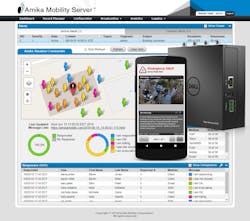Amika Mobile bolsters emergency communication capabilities for smart cities
At GSX 2019 on Tuesday, Amika Mobile (Booth #2622) announced a new OEM partnership with Dell that will extend the company’s emergency communications capabilities to future smart city deployments. As part of the partnership, Dell will embed the Amika Mobility Server (AMS) into its Edge 3000 and 5000 series IoT gateways, enabling first responders, city officials and others to push out emergency alerts to residents at a moment’s notice.
According to Sue Abu-Hakima, the Co-Founder and CEO of Amika Mobile, Dell initially approached them two years ago when they first introduced their Edge devices and expressed interest in having the AMS platform integrated with them. Among the primary target markets for the AMS-embedded gateways include users of FirstNet, the dedicated first responder network developed by AT&T.
“With these smart Edge Gateway devices, which are a part of Dell’s overall IoT push, you will be able to have these in vehicles, so you can have them on a police car, fire truck, EMS unit, installed on a wall, distributed across a stadium or however the customer needs it to be and within that there will be the functionality to be able to integrate, get information and then send out messages that you need on the fly,” she says. “With respect to the gateway, the first set of targets is around first responders but it’s also useful for any organization to be able to have it installed on a box… so we’ll be doing drop shipping of these boxes wherever in the world and people can be up and running within a few hours, if not shorter than that, because it simplifies what they have to do.”
Unlike many other mass communication solutions that require people to pre-register to receive alerts, Amika Mobile’s technologies allow organizations to push notifications to all mobile devices connected to a given network.
“We decided to take a different approach and we said, ‘well, since these devices are on networks and if people have our product on the network, then we should be able to automatically discover mobile devices and send messages to them.’” Abu-Hakima explains. “With enterprises, we would be integrated with their active directory so we would have access to their corporate information and be able to put out information that way, but for things like visitor centers, manufacturing facilities, distribution centers and so on where people are coming in and out every day and the company doesn’t necessarily know who’s in the building, that’s where we really provide extra leverage. And not only do we push out all of the alerts on all of the different layers, but we can also receive responses. In a command console, you can see who has responded and who has not.”
In addition to sending emergency messages to devices automatically discovered on a network, Amika Mobile also has the ability to integrate with access control and shot detection systems and send alerts via those solutions as well.
“When we started to go out and see customers, they asked, ‘can it integrate with my access control?’ As you can imagine they have a lot of investment in access control technology, camera technology and so we went off and we decided that we better start getting certified and we were the first (mass notification) product certified with Lenel back in 2011, and we’ve since certified with companies like Johnson Controls/Tyco, AMAG and so forth,” Abu-Hakima says. “We are also integrated with active shooter systems, such as SDS (Shooter Detection Systems), Tracer Technologies and others.
“AMS itself is distributed platform with underlying AI and IoT (technologies) and it can take on any physical system event that we integrate with – access control, fire, cameras, gunshot detection, panic buttons, etc.,” she continues. “We take any of those events into AMS and with an intelligent transaction engine, we can then push that out to anything; pop-ups onto mobile phones or tablets, text of SMS messages, roadway signs, turn on strobe lights, first responder radios, speaker systems, you name it. Not only that, it gets pushed out through social media as well.”
AMS can run either on-premise, in the cloud or a hybrid model that leverages a combination between the two. “The way we deliver this to sports stadiums, for example, they typically prefer the hybrid model because their view is someone is going to take out the command center, so they need to be replicated into the cloud,” Abu-Hakima adds.
Given all of the mass shootings that the U.S. has experienced lately, Abu-Hakima says that mass notification solutions will have to become even more intelligent moving forward with the aid of technologies like machine learning.
“We have to be putting outsmart systems to try and protect people and ones that work well with people,” she says. “I think AI has a really good role to play as we go forward, not just for taking massive data and crunching it but actually also being a lot smarter in terms of the threats and trying to measure and monitor them to maybe reduce the burden a bit in these sad situations we find ourselves in.”
About the Author:
Joel Griffin is the Editor of SecurityInfoWatch.com and a veteran security journalist. You can reach him at [email protected].



